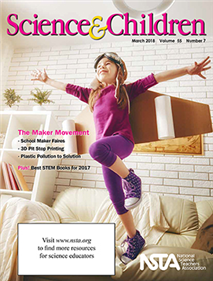Tinkering: How open-ended should it be in early childhood?
By Peggy Ashbrook
Posted on 2018-04-30
The easy answer to this question is “it depends.” It depends on the reason for providing the experience and the particular materials for young children to use. Of course children often set up their own tinkering experiences using materials at hand and may or may not have a goal in mind. I want all children to have these kinds of open-ended experiences, yes and, also have some guided making experiences to learn about construction techniques they might not discover on their own.
The National Association for the Education of Young Children’s social media site, “Hello,” has a discussion on the topic of tinkering moderated by Cate Heroman, author of Making and Tinkering with STEM: Solving Design Challenges with Young Children. Heroman also presented a webinar on the topic. She adapts the Boston Children’s Museum’s definitions of “tinkering,” “making,” and “engineering.”
The Boston Children’s Museum and the National Grid Massachusetts produced a Tinker Kit: Educators’ Guide to “inspire you to use everyday materials—scissors, paper, egg cartons, pipe cleaners—to help young children develop the muscles in their hands, practice their fine motor skills, and explore materials to understand how they work.”
 The “Making Is Fun but Are They Learning?” video from the research-practice partnership, the California Tinkering Afterschool Network (CTAN), provides guidance on preparing to teach or facilitate children’s making. “Maker educators and facilitators need hands-on opportunities to try and learn through the same making activities that they will later facilitate with young learners. Professional development for making should involve:
The “Making Is Fun but Are They Learning?” video from the research-practice partnership, the California Tinkering Afterschool Network (CTAN), provides guidance on preparing to teach or facilitate children’s making. “Maker educators and facilitators need hands-on opportunities to try and learn through the same making activities that they will later facilitate with young learners. Professional development for making should involve:
- Engaging in discussions about equity
- providing first-hand experiences with Making
- Exploring how to develop a culture of inquiry
- Positioning students as experts, mentors, and coaches”
Read the comment section with responses from Bronwyn Bevan and other presenters for more insight about how Making can support children’s STEM learning and help educators allow “youth to struggle through their questions and come to their own (and therefore owned) understanding.” The youth involved with CTAN were older than the early childhood years but the insights apply to educators working with younger children.
“They are driven to become fluent with STEM concepts and practices in order to succeed in what they themselves want to do.”
“Particularly for educators without formal STEM backgrounds, there is a danger that getting the product “right” and “done” can take precedence over allowing youth to struggle through their questions and come to their own (and therefore owned) understanding. Or in the context of Making, that educators might adopt a step-by-step building approach in which nothing really can go wrong. Everybody gets the same thing right and done at the same time; and so learning is somewhat limited. (We think by the way that there is a place for such step-by-step activities, but as stepping stones for more ambitious, creative, and open-ended work.)”
The Making as a Strategy for Afterschool STEM Learning Report from CTAN Research-Practice Partnership describes tinkering as “educative Making…organized around Open-Ended Inquiry—learners develop an individual idea or goal for making something and figure out how to accomplish it.” The report says that tinkering “can provide a concrete purpose and relevance for engaging in STEM concepts and practices” (page 1).
Some additional resources from the California Tinkering Afterschool Network (CTAN) to reflect on as you consider the way you include or plan to include tinkering as part of your educational practice:
- Equity in Afterschool Resources section
- “Tinkering as the Context for Equity-Oriented STEM Learning” video and accompanying blog post, Learning and Equity: Tinkering Afterschool Program, about the Tinkering Afterschool Program collaboration between the Exploratorium and Boys & Girls Clubs of San Francisco.
 In case you haven’t gotten to it yet, the entire March 2018 issue of Science and Children focused on making. I wrote about honoring children’s capacity to engage in science and engineering practices and design solutions for problems by promoting open-ended making of solutions that arise out of their own experiences.
In case you haven’t gotten to it yet, the entire March 2018 issue of Science and Children focused on making. I wrote about honoring children’s capacity to engage in science and engineering practices and design solutions for problems by promoting open-ended making of solutions that arise out of their own experiences.
If you want to get experience tinkering yourself, consider signing up for the Coursera course, “Tinkering Fundamentals: Motion and Mechanisms” by Exploratorium at coursera.org
Disclaimer: The views expressed in this blog post are those of the author(s) and do not necessarily reflect the official position of the National Science Teaching Association (NSTA).



